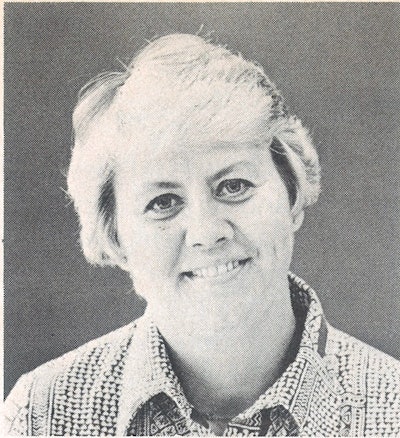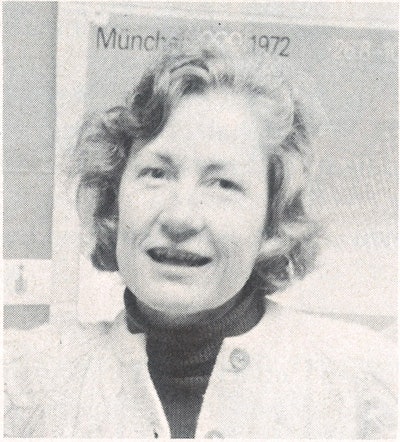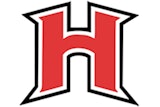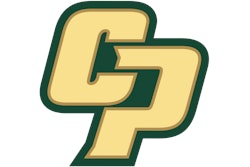This article originally appeared in the March 1979 issue of AB with the headline, “The Time Has Not Yet Come.” Dr. Kaye Hart, director of women's athletics, Temple University
Dr. Kaye Hart, director of women's athletics, Temple University Dr. Carol Ogelsby, associate professor of physical education, Temple University
Dr. Carol Ogelsby, associate professor of physical education, Temple University
John Toner, Athletic Director at the University of Connecticut, in the November and December issues of this publication, proposed a merger of the AIAW and the NCAA. The following is a response by Kaye Hart, AIAW Rules Standards Committee chair, and Carol Oglesby, former AIAW and NAGWS president.
The “Toner Solution” is quite a perfect exemplification of why the merger of NCAA and AIAW is presently unacceptable to the great majority of women in collegiate athletics. It is very instructive to look at the wording of Toner’s conceptualization of the needed reorganization: “The present structure of the NCAA…expanded… (and championships) instituted for women” (emphasis ours.) It will all be done for us, you see, and in the style and fashion the NCAA feels is best for us. Do the women in AIAW again have to be protected and guided and “have our doors opened for us again”? Have we suffered and missed this service so much? The AIAW leadership is committed to the view that the final decision with respect to separate or unified governance of intercollegiate athletic programs be made on individual campuses with equal input from fully-informed female and male athletic personnel. The solution will note be made either by the NCAA or by male athletic directors and imposed on women’s programs.
What women would surrender in this proposed merger is having a significant and equitable voice and vote in the governance of university sport, both nationally and internationally. Talk about selling one’s birthright for a “mess of pottage!”
There are several problems, both general and athletics-specific, which doom Mr. Toner’s proposal. We shall describe these briefly and conclude with some thoughts concerning what conditions might portent the exploration of merged governing bodies.
General Problems
- It is not a perfect world.
In “One Set of Rules for All Student-Athletes,” (Athletic Facilities and Purchasing, November, 1978) Mr. Toner describes how it makes such “good common sense” that separate but equal governance is unnecessary. His comments might be true in a world where there was no past history of blatant discrimination against women. (We say “might” because there is no natural law which proves unitary governance is better. Mr. Toner’s analogy to the contrary, local, state and national governments or, for that matter, the American sports community, are not unitary or even “under a single umbrella” in this pluralistic country. Far from it!) Nonetheless, this is not a perfect world and sexist beliefs about women still inform much thinking related to sport. Such discrimination, which exists in perhaps as much as 75 percent of America’s colleges and universities, makes the virtues of easy administration and application of precisely the same rules and regulations comparatively unimportant.
An organizational structure which buries the voice and vote of women prolongs interminably the day when women in sport will be equitably recognized. Certainly in Mr. Toner’s merger the voice and vote is buried. When he states in his second article that women will have a greater per capita opportunity (emphasis ours) to be named chief executive officer and faculty representative to the “expanded NCAA,” he uses “nonspeak” to describe a condition where token women at best would speak for their institutions’ athletic programs. How many women in stark reality today can honestly feel there is more than a token chance, based on politics not quality, or their being elected or appointed to the NCAA council under Mr. Toner’s formula? (The NCAA council and NCAA executive committee can only be selected or appointed from institutional faculty representatives, athletic directors or chief executive officers, groups now comprised of over 90 percent males. Because of this available pool of male personnel, even voting at the NCAA convention becomes an exercise in tokenism.
- Women are not a special interest group.
Mr. Toner (December, 1978) equates the question of women on NCAA general committees to the representation of other “special interest groups.” Clearly, this method of regarding women is based on a patently false assumption! Women comprise approximately half the college population. They should make up half the student-athlete population and they should make up approximately half the governance structure of any organization which purports to represent both women and men. This means women should occupy half of the membership slots at the top level (NCAA council) of control and decision-making. Why would women consider a thin slice of the cake when we have the whole cake, top to bottom, now? The idea of equity being served by one woman on some NCAA committees is, to say the least, disproportionate.
Athletics-Specific Problems
- Division classification and voting
An institution having men’s and women’s programs in differing divisions in the “expanded NCAA” would apparently be precluded from voting on some issues which crossed divisions. It should be noted that this problem does not arise at present in the AIAW since the division restructuring plan adopted by the 1978 AIAW delegate assembly allows divisions no separate rule-making powers and all members regardless of division vote on all issues. The cross-divisional voting problem would bring strong pressure to bear to have both male and female programs in the same division whether this practice were best for each program or not and would force women’s programs into the major/minor concept. Thus women are skeptical, and for good reason, about whether the interests of the women’s athletic program would be paramount. The AIAW allows an institution to select divisions on a sport by sport basis. Why does not Mr. Toner address this option?
- Sport committees and rules development
AIAW has a framework totally different form the NCAA’s for developing championship rules (as differentiated from play rules), one which has worked exceptionally well (see later remarks on rule development.) Why should the AIAW have to change its sport committee framework to accommodate the NCAA? Why should the AIAW have to change its geographic boundaries? The AIAW’s coordinated unitary structure (state, regional and national units) allows for the fair and orderly conduct of championships for student-athletes all of whom meet the same eligibility requirements regardless of locality, conference, state or region. Regional officers and elected student-athletes play a very important role in the governance of AIAW. (Championship rules are set by the sport committee for each sport while playing rules are governed by NAGWS with considerable interaction between the two groups and the national championship commissioners.)
Mr. Toner’s figures have grossly underrepresented the funding necessary to continue AIAW’s present level of services, both in the volunteer network dealing with general, championship and ethics and eligibility matters, and for publication and dissemination services provided by the NAGWS. Why the AIAW should exchange its effective unitary and sport committee framework has not been made clear.
- Number of participants
The implication that performance standards have not been stringent at AIAW championships is quite inaccurate. Additionally, the automatic linking of tournament expansion to net receipts is inappropriate in an environment which has such a long history of discrimination against women in sport especially in such critical areas as media exposure, availability of adequate facilities at desirable time slots, adequate administrative and support personnel and the like. Exactly how many championships in how many divisions would the NCAA wish to institute at the outset to duplicate the present AIAW program? And how dependent will the championship schedule be upon net receipts? Linking the structure and offering of championships to net receipts appears to be an unwelcome interjection of big business commercialism and “the winning cycle” into the world of women’s intercollegiate athletics, which is not committed to the “process” of the experience and welfare of the student-athlete. Further, the number of participants in national championships should depend on the popularity of the women’s sport rather than on any preconceived emphasis according to what the “comparable” men’s sport is or whether the sport is judged to be “major” or “minor.”
- Staffing
The narrow view of women’s concerns in collegiate sport is also evident in the section on additions to NCAA’s events department. Staff people hired in this area would concern themselves solely with women’s championship events. The present AIAW staff expertise and concerns range over every problem/challenge in athletics today. Why they should trade this for championship oversight responsibilities is inconceivable. Why be limited to painting one flower on the athletic canvas tomorrow when we can paint the whole picture today?
In limiting entry to leadership both on the national staff and institutional levels, the NCAA would virtually eliminate a generation of female leadership and expertise developed in the past decade at inestimable loss to society itself and to the students who have been deprived of needed and desirable role models.
- Financing
It is particularly significant that Mr. Toner estimates the cost of NCAA women’s championships and related support at $1.6 million, while AIAW is presently funding the same number of championships and all services for less that $500,000. Considering the finances of today, the moral of the story would appear to be that since the women are two to three times more efficient, we should probably offer to take over the NCAA and administer it for half the price.
Further, this insistence on wholesale spending imposes the major/minor emphasis found in the male model of athletics exactly where it is lease desirable. For example, in the proposed budget (as evidenced by transportation costs and number of competitors,) basketball is given $215,300 while volleyball is allotted only $22,800…this despite the fact that volleyball is the second largest female sport (in 1977-78, 795 institutions had basketball programs, while 703 had volleyball programs.) It seems a shame that just when the American sport scene is showing signs of increased participation and delight in all forms of sport not to allow for the natural evolution of women’s programs.
Mr. Toner’s plan tries to lure institutions to the NCAA through travel and possible per diem kickbacks. Some readers, who would have welcomed more equitable spending on women’s programs and are by now used to bake sales to support underfinanced institutional programs, would be willing to resurrect the old pie pans to raise money for championship travel rather than allow a “submerge-r” with the NCAA. However, participation and spectator interest in women’s athletics is increasing drastically to the extent that the AIAW may soon be able to begin paying championship travel expenses. Such a motion, in fact, went before the 1979 AIAW delegate assembly.
When Will the Time Be Right?
At the present time, the AIAW membership remains united in their common belief in the essential justice of Title IX and in the mandate for AIAW to continue to act as the sole governing body for women’s intercollegiate athletics. (A survey of NAIA, NCAA and AIAW institutional presidents, voting representatives and athletic directors conducted by the AIAW in December, 1978, indicated that 86 percent of the athletic directors and 82 percent of the presidents favored separate governance of women’s intercollegiate athletics. A survey conducted by NACDA in the winter of 1978 produced similar results.) In any future merger with the NCAA, the “trust factor” would have to be carefully weighed, since the AIAW was created out of the void which existed through the failure of the men’s governing bodies to provide full and equitable programs for women. The NCAA has historically been opposed to the expansion of women’s programs and was in court as recently as a year and a half ago in their fight against Title IX—first to exempt intercollegiate athletics from the Education Act of 1972 and then to exempt revenue-producing sports from Title IX.
We believe that sometime in the future conditions might be auspicious for discussions of unitary intercollegiate sports governance to begin, keeping in mind that this is not necessarily the only option to envision for the future.
How will we know when that time has come? First, women and men will be equally willing to make significant changes in their own organizations. For example, both the NCAA would modify their names and traditional geographic boundaries.
Secondly, we will find that women and men have equal voice and vote in all matters that concern the new organization, from television contracts to international franchise disputes.
Thirdly, women and men will have publicly acknowledged and actively pursued affirmative action steps to end age-old patterns of discrimination.
Finally, men will have acknowledged that women’s groups have come closer to solving certain athletics problems than have the men’s organizations and consultations will have begun. (For example, AIAW cooperates and has a principle voice in the writing of rules by the National Association of Girls and Women in Sport. The NAGWS has been writing and publishing sport rules for girls and women since 1899. The NAGWS rules are prepared with three guiding principles: a) rules are for the good of those who play; b) international rules should be utilized wherever appropriate; and c) rules writing should include representation from all groups which use the rules. The NAGWS-AIAW believe they have established a framework which could be beneficially modeled by various governing groups in sport. Why hasn’t this recognition occurred? When it does come, perhaps it will be another signal indicating the time has come.
In conclusion, we have no doubt that John Toner’s intentions were the best. Unfortunately, he could not escape the effects of his time, nor his place; nor can any of us completely. Thus we know the time has not yet come.




































